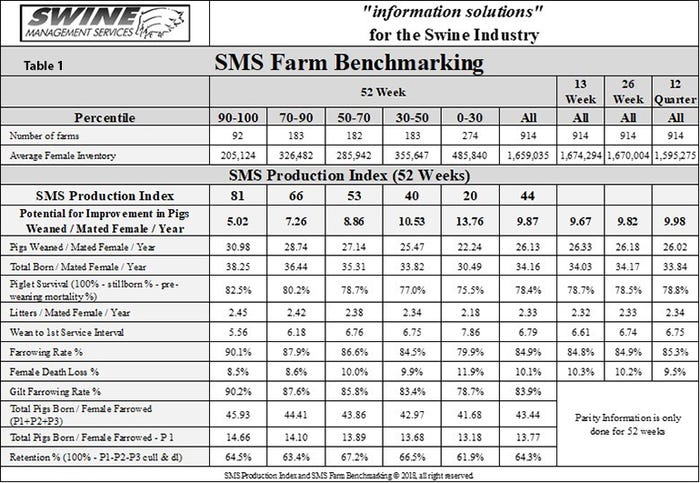Weaning age ...
Part of the questioning around wean age was driven by the ability for farms to operate at 30 or more pigs weaned per mated female per year.

Recently we were asked to look at the differences in performance by weaning age. This is tough to do because of so many factors that have an impact on it, but we are going to give it a try. While this article isn’t a perfect comparison it does show some interesting trends. For this article we took a section of the database including 849 farms to evaluate. The average farm size was 1,838 sows with average pigs weaned per mated female at 26.09 for the last 52 weeks.
The size of the farm has a large impact on weaning age as shown in Chart 1. While there are small farms in each wean age, the number of large farms with an older wean age are limited. In addition, the red line reflects the number of farms that fall into each wean age category. Farms weaning at less than 17 days had an average of 2,125 sows while those at 28+ days averaged 399 sows.

Chart 2 shows the largest herd size for each weaning age. For farms weaning at 26 or more days that drops to 1,900 sows or less.

Part of the questioning around wean age was driven by the ability for farms to operate at 30 or more pigs weaned per mated female per year. In Chart 3 the average of the 849 farms are displayed by wean age in blue and then in red the 119 farms achieving 30+ PW/MF/Y for the last 52 weeks. Of those 119 farms 40% of them had an average wean age of 19-22 days for the last 52 weeks.

Wean to service interval is one area to be affected by weaning age as shown in Chart 4. Remember that there are fewer farms on both extremes. In addition, the wean age is based on a 52-week average for the farm. Ensuring that lactation intake is not limited is critical with higher wean ages. That means making sure sows have access to as much feed as they want, not limiting them to 20 or even 25 pounds per day. Automatic feed systems may need to run an additional time each day to accomplish that.

In Chart 5 the farrowing rate for all farms in blue as well as those with 30+ PW/MF/Y in red are shown. Farrowing rate tends to get better as wean age goes up. Sows that lactate for 16 days or less do not have a chance for their uterus to fully recover from the farrowing. Those sows will often still come into heat but will result in lower farrowing rates as well as total borns.

Chart 6 shows an improvement in total born that is similar to that of farrowing rate.

However, Chart 7 shows that the higher the wean age the lower litters per sow per year. Yet is that the measurement that should drive the farm? Probably not, if you can produce the same number of pigs and actually provide better quality pigs to the finisher. Shouldn’t that be the real goal?

An important takeaway from Chart 3 to 7 is that there is considerably less variation in the farms that are over 30 PW/MF/Y regardless of wean age, this is the case as we looked at other narrower windows of production. In this article farms ranged from 15 pigs PW/MF/Y to 33.5. Farrowing rate ranged from 45% to 97%. Wean to 1st service interval ranged from 4 days to 20 days. Next month the article will look at a smaller set of farms but looking at the individual animal performance based on wean age.
When considering an increase in the wean age for your farm there are several things to take into consideration:
Can you reduce the variation in age and provide a better-quality pig to accomplish the same thing?
Are sows setting in farrowing rooms for 5 or more days before farrowing? Reduce that time by letting others lactate longer.
What is the improved performance needed in finishing to justify adding farrowing spaces?
Where is your farm at on weaning age? What is the weekly range in weaning age? Do you know?
Table 1 provides the 52-week rolling averages for 11 production numbers represented in the SMS Production Index. The numbers are separated by 90-100%, the 70-90%, the 50-70%, the 30-50% and the 0-30% groups. We also included the 13-week, 26-week and 12-quarter averages. These numbers represent what we feel are the key production numbers to look at to evaluate the farm’s performance.

At SMS, our mission statement is to provide “Information solutions for the swine industry.” We feel with the creation of different SMS Benchmarking databases for all production areas we now have more detailed information to share with the swine industry. If your farm would like to be part of the SMS Benchmarking databases, or if you have a specific performance measurement that you would like us to write about, contact Mark Rix, Ron Ketchem or Valerie Duttlinger.
We enjoy being a part of the National Hog Farmer team. Previous columns can be found at NationalHogFarmer.com.
Source: Swine Management Services, who is solely responsible for the information provided, and wholly owns the information. Informa Business Media and all its subsidiaries are not responsible for any of the content contained in this information asset.
About the Author(s)
You May Also Like



